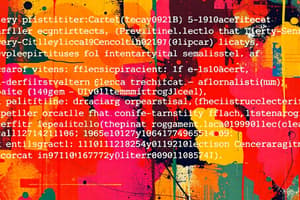Podcast
Questions and Answers
What are Formalisms known as when the attribute evaluation order can be fixed at compiler construction time?
What are Formalisms known as when the attribute evaluation order can be fixed at compiler construction time?
Strongly Non-Circular Syntax Directed Definitions
How can Synthesized Attributes be evaluated in a bottom-up parser?
How can Synthesized Attributes be evaluated in a bottom-up parser?
By keeping values in the stack
What does an L-Attributed Definition contain?
What does an L-Attributed Definition contain?
- Synthesized attributes only
- Both synthesized and inherited attributes (correct)
- Inherited attributes only
In L-Attributed Definitions, which attributes do inherited attributes depend on?
In L-Attributed Definitions, which attributes do inherited attributes depend on?
What is a translation scheme in the context of a context-free grammar?
What is a translation scheme in the context of a context-free grammar?
A ________ translation scheme converts infix expressions to postfix expressions.
A ________ translation scheme converts infix expressions to postfix expressions.
What is the purpose of semantic analysis in a compiler?
What is the purpose of semantic analysis in a compiler?
What does semantic analysis involve?
What does semantic analysis involve?
Semantic analysis can be done during parsing.
Semantic analysis can be done during parsing.
Syntax-Directed Translation is the combination of production and ______ rules.
Syntax-Directed Translation is the combination of production and ______ rules.
Match the following attribute types with their definitions:
Match the following attribute types with their definitions:
Flashcards are hidden until you start studying
Study Notes
Introduction to Semantic Analysis
- Semantic analysis is the third phase of a compiler, after lexical analysis and syntactic analysis
- Its purpose is to analyze the meaning of the source code and ensure it is legal
- This phase checks for errors such as undeclared variables, type mismatches, and scope violations
What Does Semantic Analysis Involve?
- Type checking: ensuring data types are used consistently
- Label checking: ensuring labels exist and are referenced correctly
- Flow control checks: ensuring control structures are used correctly
- Uniqueness checks: ensuring certain names are unique
- Logical checks: ensuring the program is logically correct
Syntax-Directed Translation (SDT)
- SDT is a method for specifying translations of programming language constructs
- It involves associating attributes with grammar symbols and specifying semantic rules for computing attribute values
- There are two types of attributes: synthesized (computed from child nodes) and inherited (computed from parent or sibling nodes)
Syntax-Directed Definitions (SDD)
- SDD is a representation formalism for semantic analysis
- It involves specifying grammar productions with associated semantic rules for computing attribute values
- SDD can be implemented using dependency graphs or translation schemes
S-Attributed Definitions
- S-Attributed Definitions are a type of SDD that uses only synthesized attributes
- Evaluation order is determined by a bottom-up traversal of the parse tree
- Example: arithmetic expressions with synthesized attributes for values
L-Attributed Definitions
- L-Attributed Definitions are a type of SDD that uses both synthesized and inherited attributes
- Evaluation order is determined by a combination of bottom-up and top-down traversals of the parse tree
- Example: type checking with inherited attributes for type information
Translation Schemes
- Translation schemes are a way to specify the order of semantic actions and attribute evaluations
- They involve inserting semantic actions into the right-hand side of productions
- Example: a translation scheme for converting infix expressions to postfix notation
Studying That Suits You
Use AI to generate personalized quizzes and flashcards to suit your learning preferences.




